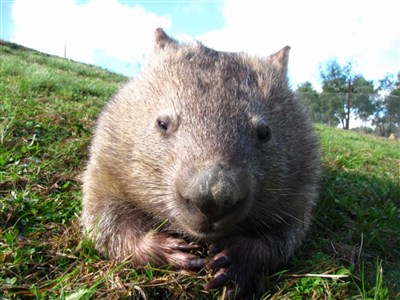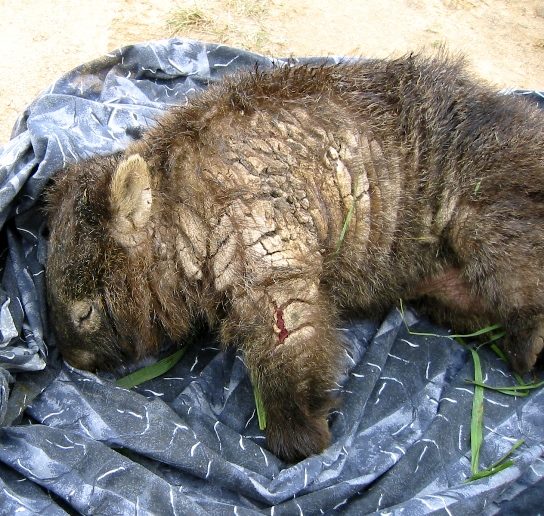Sarcoptic mange in wombats has reached catastrophic proportions, causing mass decline of at least 70% of bare-nosed wombats in Australia across NSW, Victoria, and Tasmania. Some local wombat populations (and their genetic diversity) are already extinct. Sleepy Burrows Wombat Sanctuary has had repeated success administering an alternative oral treatment with wombats in quarantined care, as opposed to unsuccessful conventional topical treatments. This new and effective approach significantly decreases treatment time and wombats recover fully.
This crowdfunding campaign will raise vital funds for a design research study at Sleepy Burrows in collaboration with
Queensland University of Technology (QUT) to achieve two aims:
1. To design and trial purpose-built quarantine hospital burrow enclosures to ease the treatment administration of sarcoptic mange in bare-nosed wombats;
2. To document, analyse and evaluate this new mange treatment procedure and contextual factors applied to wombats in quarantine care using the new burrow design.
The study’s findings will help to prepare a larger scale deployment.
What is Mange?
The bare-nosed wombat (Vombatus ursinus) is iconic to Australia’s biodiversity, yet the population is significantly threatened and at risk of becoming locally extinct due to sarcoptic mange [1-6]. Sarcoptic mange is one of the most uncomfortable skin diseases that a mammal can contract. Mange is highly contagious. It is caused by a mite called Sarcoptes scabei var. wombati [3]. These mites burrow into a wombat’s skin, causing scaling, crusting, hair matting and hair loss, and severe itching (Figure 1). Once a wombat’s eyes and ears are affected, it can turn these nocturnal animals blind and deaf. Severely affected wombats lose orientation and are frequently seen during daytime. For wombats it is the most threatening disease and causes arguably the most agonising, painful and prolonged suffering over months, which is always fatal without treatment.
Figure 1: Wombat with advanced sarcoptic mange lesions
What are we trying to do?
Once we reach our funding target, this project will be rolled out in two phases:
Phase #1: To document, analyse and evaluate sarcoptic mange treatment applied to wombats in quarantine. Sleepy Burrows has had repeated success in administering an alternative oral treatment – rather than the conventional topical treatment – for wombats with sarcoptic mange in care at Sleepy Burrows. This study uses a design-led research approach to document and evaluate this new treatment procedure and contextual factors in order to prepare for large scale deployment. Together with the QUT team, we will conduct an extensive field study at Sleepy Burrows Wombat Sanctuary (Gundaroo, NSW) to analyse and evaluate the current treatment procedure from both veterinary and design perspectives, and to consider use of the facilities by humans and animals.
Phase #2: To build and trial a hospital burrow in situ.
The data will be used to inform a design-led approach that will deliver the fabrication specifications for a prototype “quarantine hospital” burrow enclosure (Figure 2). These are enclosures large enough to house a wombat in quarantine for the duration of the treatment, but still within a natural environment while undergoing treatment. The burrows are purpose-built so that sections can be lifted in order to locate a wombat underground for treatment purposes. This avoids the pitfalls of current approaches involving trapping and burrow flaps, leading to under-treatment and further suffering. The prototype will be trialled in situ.
Figure 2: Initial sketch of hospital burrow design
The study’s findings and insights will help us to inform and prepare for a larger scale deployment beyond the sanctuary. The treatment procedure documented in phase #1 has to be refined towards reliable replicability so it can be administered without specialist assistance. The prototype design for the hospital burrow developed in phase #2 has to be optimised in a package, so large numbers can be produced and deployed in a robust, reliable and cost-effective manner.
Why is your approach different?
To our knowledge, our proposed method combining a working oral mange treatment with the design of a purpose-built quarantine hospital burrow enclosure has not been attempted anywhere in Australia outside Sleepy Burrows Wombat Sanctuary.
The conventional burrow flap topical treatment method currently being used across Australia to tackle mange in wombats has limitations. No reliable data exists to show its sustained success or avoidance of treatment resistance over time. Wombats are territorial animals, and often fight over burrows meaning they do not always return to the same burrow for the required treatment period. A manged wombat is thus not guaranteed the continuous application of topical treatment through the burrow flap method. Missing treatment doses prolongs the wombat’s suffering and leads to treatment resistance over time, as well as spread of the disease to other wombats.
Effective oral treatment does exist and has been applied successfully with long term results. The knowledge gap is thus not so much about treatment itself but the type of treatment used, scale of deployment to full recovery, and recurrence rate. This project aims to conduct design-led research and evaluation to inform the fabrication and trial of a quarantine hospital burrow for the treatment of mange in wombats.
Why is this project important to Australia?
Australia has the highest rate of species extinction globally. The speed at which mange is spreading and decimating whole wombat populations puts this iconic Australian marsupial at risk of dying out. Mange represents a silent epidemic that not only causes a horrific and prolonged illness in the animal, but also threatens to further erode Australia’s biodiversity. Wombats are tough creatures, known for their strength and tenacity. However, mange – introduced by humans when foxes were released for hunting – is something they cannot defeat without the help of those who brought this illness upon them.
Through helping to understand how we can stop the suffering and improve the health of wombats, this project contributes to protecting Australia’s biodiversity and preserving the rich ecosystem heritage for all to cherish into the future.
Who are you?
Donna L. Stepan is a 2017 nominee for Australian of the Year. She was awarded the Medal of the Order of Australia (OAM) in 2017 for her service to animal welfare. She has helped over 1,000 bare-nosed wombats survive and grow up over the last decade, and even more that have indirectly benefited from her work as an Australian native wildlife rescuer, conservationist, advocate, and educator.
References
1. Evans, M. C. 2008. Home range, burrow-use and activity patterns in common wombats (Vombatus ursinus). Wildlife Research 35, 5: 455–462.
2. Fraser, T. A., Charleston, M., Martin, A., Polkinghorne, A., & Carver, S. 2016. The emergence of sarcoptic mange in Australian wildlife: an unresolved debate. Parasites & Vectors 9, 1: 316.
3. Hartley, M., & English, A. 2005. Sarcoptes scabei var. wombati infection in the common wombat. European Journal of Wildlife Research 51, 2: 117–121.
4.
Old, J., & Deakin, J. 2015. Mangy marsupials: wombats are catching a deadly disease, and we urgently need a plan to help them. The Conversation. Retrieved April 29, 2018 from
https://goo.gl/kMnyQD
5. Simpson, K., Johnson, C. N., & Carver, S. 2016. The Mange Mite with Mighty Effects on the Common Wombat. PloS One 11, 3: e0149749.
6. Skerratt, L. F., Martin, R. W., & Handasyde, K. A. 1998. Sarcoptic mange in wombats. Australian Veterinary Journal 76, 6: 408–410.




